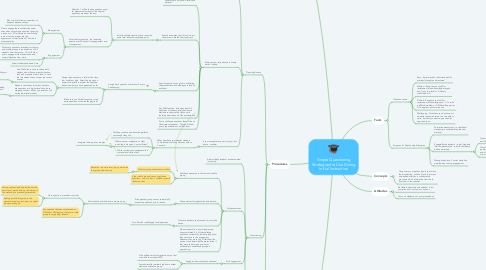
1. Principles and Rules
1.1. Easy questions go to students in bottom 3rd of the class
1.2. Difficult questions go to students in the top 2/3s
1.3. Medium questions go to top 2/3s except when you feel that lowest 3rd can engage effectively
1.4. Don't call on students because they have their hands up, call on the students you planned to call on
1.5. Call on students when they raise their hands to try to answer a question that would normally be outside their difficulty range
1.6. Create a specific signal for use by students when they know the answer to one of the challenge questions you keep on the board for use at any time during the intro
2. Procedures
2.1. Planning Process
2.1.1. Use the Silverleaf Lesson Plan Template Form and Procedure - Already Known
2.1.2. Write out your introduction in minute detail. Include:
2.1.2.1. Summary of how you will introduce material
2.1.2.2. Specific examples you will use, do not summarize, write the exact example
2.1.2.2.1. Include multiple questions at or near the same level at each questioning point.
2.1.2.3. Specific questions you plan to ask during the presentation and where you intend to ask them.
2.1.2.3.1. Assign each question a level from Easy to Challenging.
2.1.2.4. Key Skill Question: Include at least 2-3 questions at the easy level that require students to execute the skill you are teaching near the end of the presentation
2.1.2.5. Some challenge questions that will be on the board throughout. These will allow your high achievers to work ahead.
2.1.3. If you retaught at any point in your last lesson, consider
2.1.3.1. What questions you thought students could answer that they were not able to. Consider
2.1.3.1.1. Did they not have prior knowledge/skills you thought they did
2.1.3.1.2. What was your explanation of that point/topic. why was it not sufficient?
2.1.3.1.3. Which students did understand the material and which didn't.
2.2. Questioning
2.2.1. After multiple students have answered incorrectly
2.2.2. For Assessment
2.2.2.1. Ask these questions to the low and middle group
2.2.2.1.1. If the low group cannot answer these
2.2.2.1.2. If the middle group does not get these questions, no more than 1 mistake, reteach the entire class
2.2.2.2. Ask questions throughout the introduction.
2.2.2.2.1. If the planned group cannot successfully answer the question, ask for hands
2.2.2.3. Question students you planned to, only take hands
2.2.2.3.1. For difficult or challenging level questions
2.2.2.4. When students from your higher group have completed 2-3 of the challenge questions successfully, let that group know they can move to the assignment whenever they are ready. Offer them the option to consider with the presentation if they want to but move your focus exclusively to middle/low groups in questioning
2.2.3. For Engagement
2.2.3.1. Engage with questions as planned
2.2.3.1.1. Give additional time for questions you feel are within the students ZPD
2.2.3.1.2. Sometimes offer partner help from another student in the same group
2.2.4. For Management
2.2.4.1. Identify students who regularly give you management problems
2.2.4.1.1. Behavior issues
2.2.4.1.2. Students who ignore the material because they don't expect to succeed
2.3. Popsicle Sticks
2.3.1. Download Popsicle Sticks (PS) to your phone
2.3.2. Complete Popsicle Sticks Training with Gerald
2.3.2.1. Create 3 classes, low middle high
2.3.2.1.1. Add all students names to one of the classes
2.3.2.2. Create a behavior management class
2.3.2.2.1. Add the names of all behavior issues to the group
3. Interpersonal Skills
4. Facts
4.1. Question Levels
4.1.1. Easy - Simple recall or information/skills previously taught and mastered
4.1.2. Medium - Requires use of skill or restatement of new knowledge taught, but: 1) at a low level or 2) Heavily scaffolded or 3)
4.1.3. Difficult - Requires use of skill or restatement of knowledge and: 1) To solve a difficult problem or 2) Without Support or 3) To apply to a novel situation
4.1.4. Challenging - Questions you don't expect students to know answers to or be able to solve, but that you want to give them an opportunity on.
4.2. Purposes for Questioning Strategies
4.2.1. Formative assessment - to check how students are understanding the new material
4.2.2. Engage/Excite students - to pull students into the presentation, to build confidence with new material
4.2.2.1. Questions students know easily - Engage and build confidence
4.2.2.2. Questions students can do with perseverance/support - To develop effort and show students they can't get by with minimal effort.
4.2.3. Manage the class - Control discipline problems by forcing engagement

